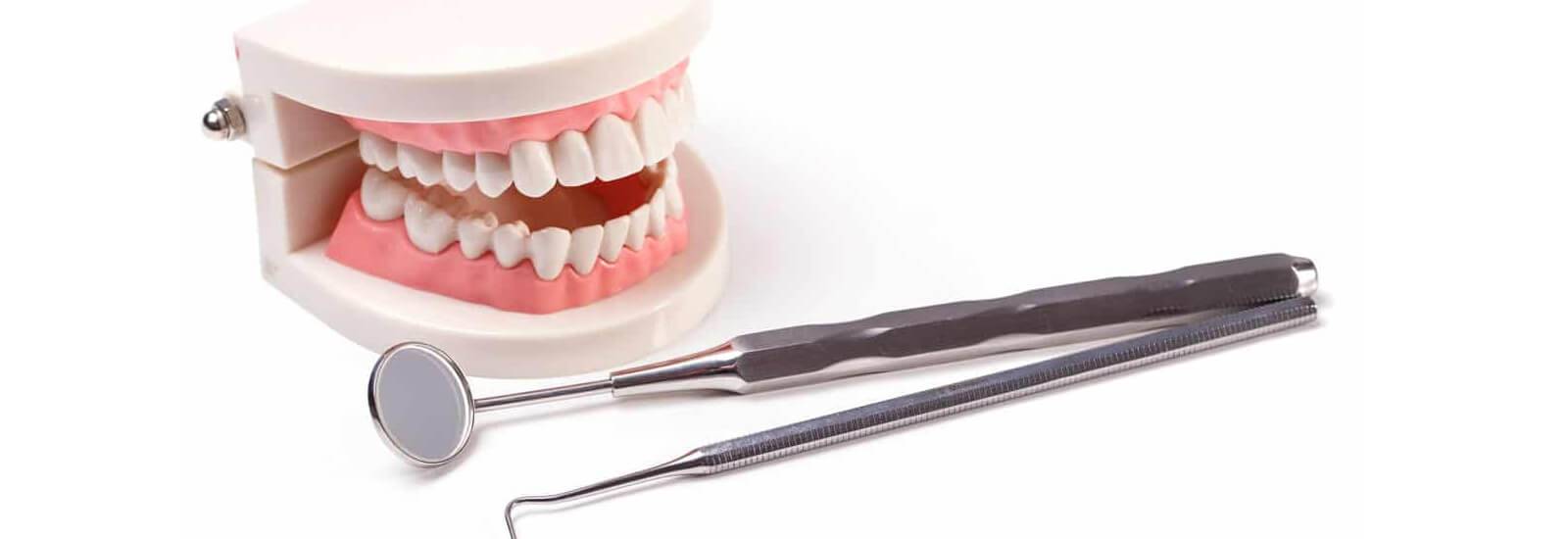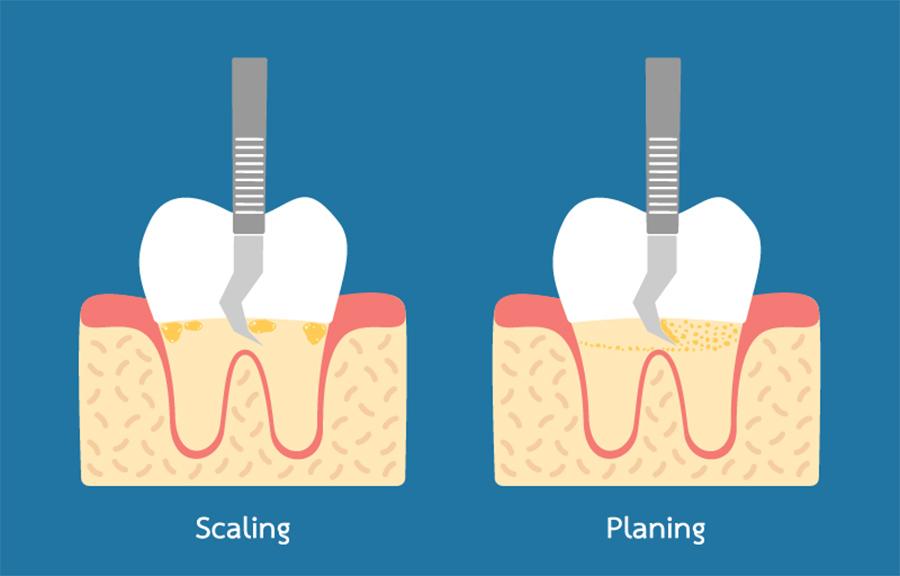Scaling and Root Planning
Teeth Cleaning treatment helps to minimize the brownish or yellowish layer on the teeth surface. Plaque or tartar are some of the reasons for this layer development. Generally, dental experts use the spray of the dental solution and water to clean. Teeth can appear cleaner with this treatment.

Talk to a Dentist Now!
Table of content
What is Scaling and Root Planning?
One of the main reasons that teeth appear brownish, Is due to the plaque layer development on them. Dental scaling is one treatment method to treat dental plaque on the teeth. Treatment done at an early stage can help to avoid later tartar development on teeth.
The dental scaling cost is relatively lower than other treatments. Root planing is needed if there is more decay on the tooth. Here root canal treatment needs to be done.
Is scaling of teeth necessary?
Bacteria cause periodontal disease. Plaque and calculus provide an irregular surface that allows these bacteria to attach easily. Scaling and root planing are done to remove the plaque and calculus. For the early stages of the disease, this treatment may be all that is needed to get the condition under control.
This is especially effective with gingivitis. With more advanced gum disease, scaling and root planing may be the first step before surgery.
Preparation
For some patients, scaling and root planing can cause discomfort. A local anesthetic may be used to numb the portion of your mouth that is being worked on. Sabka Dentist offers a few of the best scaling and root planning costs in India.
How it is Done

Scaling and root planing are done with a combination of ultrasonic scalers and hand instruments. Ultrasonic instruments are electric or air-powered. They have two components:
- A relatively dull metal tip that vibrates at a very high frequency and “knocks” plaque and calculus off the tooth
- A water irrigation system that cools the tip and helps to flush out debris from around the teeth
Hand instruments are not powered. They have cutting edges that your dentist or hygienist uses to chip away plaque and calculus. These instruments come in various shapes and sizes. Different instruments are used for different teeth, and even for different surfaces of the same tooth.
Typically, ultrasonic instruments are used first to remove large deposits of plaque and calculus from the crowns and roots of the teeth. Hand instruments called scalers and curettes are then used to remove any remaining material and ensure the tooth surface is clean and smooth.
When working under the gum line, your dentist or hygienist cannot see the plaque or calculus. He or she will rely on the sense of touch to feel roughness on the root surface.
Sometimes, scaling and root planning can be completed in one visit. This usually is possible if you have gingivitis, the earliest stage of gum disease. However, if you have periodontitis, multiple visits are usually needed. The periodontist typically will do one-quarter of your mouth (a quadrant) at each visit.
Follow-Up
For two to three days after the treatment, you may have some soreness and be sensitive to hot and cold temperatures. Over-the-counter pain relievers can help.
You may be asked to use an antiseptic mouth rinse after scaling and root planing. This is especially likely if your gums are very sore. However, you should continue brushing and flossing as usual. You can expect some minor bleeding in the first days after scaling and root planing. This usually stops within a week.
Risks
Treating periodontitis decreases gum inflammation. It also eliminates periodontal pockets, which can trap plaque. Therefore, if treatment is successful, the swelling will be gone and your gums will shrink or recede. The extent of shrinkage depends on the initial depth of the pocket and the severity of periodontitis.
The more severe the disease, the more your gums will recede after successful therapy. As a result, some part of the root is exposed. This makes the tooth look longer. It also will be more sensitive to heat and cold. To prevent root cavities, your dentist may prescribe a fluoride-containing gel. It’s also important to control plaque.
Has your medical doctor told you that you need to take antibiotics before certain dental procedures? If so, tell your dentist or hygienist about this before you undergo scaling and root planing.

When To Call a Professional
If you develop a fever or a lot of bleeding, pain, or swelling after scaling and root planing, contact your dental professional.
Visit Sabka Dentist and get lower dental scaling cost treatment near you. At Sabka Dentist, you can get quality dental scaling which gives whiter teeth.
Expert's Opinion
- Dr. Zita Antao Dental Director of Sabka Dentist says “Scaling involves removal of plaque and calculus from the teeth surface.”
- Dr. Priyanka Shingore Dental Director of Sabka Dentist says “Root Planning will smooth the tooth roots using a scaling tool. This smoothing helps your gums to reattach to your teeth.”
- Dr. Preethi Nagarajan Dental Director of Sabka Dentist says “Scaling & Root planning will help to eliminate symptoms of gum disease like bad breath, bleeding gums, inflamed gums, etc.”
Frequently Asked Questions
How much does a dental checkup cost?
At Sabka Dentist, Dental checkups and X-ray consultation is free of cost.
How often should you get a dental checkup?
Dental Checkup should be done every 6 months or biannually to detect any dental issues at an earlier stage and to maintain healthy teeth and gums.
What happens if you don’t get your teeth cleaned?
If your teeth are not cleaned regularly and if good oral hygiene is not maintained, plaque and calculus may buildup. Plaque tends to lower the pH and creates an acidic environment that may result in demineralization and tooth decay. Also, plaque and calculus buildup may result in inflammation of gums, bad breath, etc.
What does a (Periapical) Dental X-ray show?
Dental X-ray is valuable diagnostic tool that can help to confirm the final diagnosis of oral health condition. Radicular portion/ Root portion of tooth, which is not otherwise visible to the naked eye, can be displayed in an X-ray. Radiographs also help to determine the extent of decay, presence of cysts, bone loss etc. Congenitally missing or impacted teeth are often identified this way.
How many visits are needed for cleaning and shaping a root canal?
Generally, two visits are enough for the whole process. However, if required you may need four visits for cleaning and shaping of root canal purposes.
About Author

Dr. Jena after graduating as a Dental Surgeon in 2007 she started working under a well known private practitioner as an associate Dentist. After one and a half years of experience in private clinic she joined a reputed trust Total Dental Care in january 2010 and continues her work with us till the time it got converted into a large dental chain SABKA DENTIST.
Dr.Jena is associated with SABKADENTIST from the time of its inception. Initially she worked as an associate Dentist and was promoted to the post of Dental Director in August 2011. Initially she was given a responsibility of handling many operations of the clinic. Her hard work paid off when she was ultimately given the charge of Audit and Compliance of all clinics of SABKADENTIST across 5 cities. Her solitary goal is to put the company on the peak through stringent Audit and Compliance.








